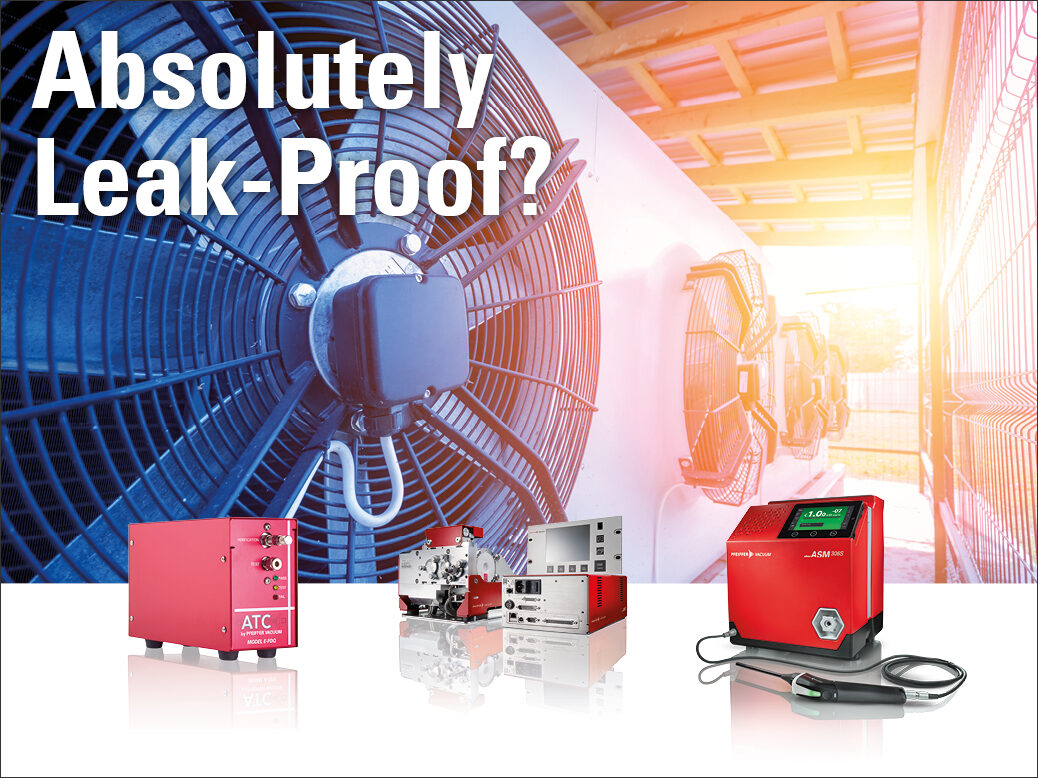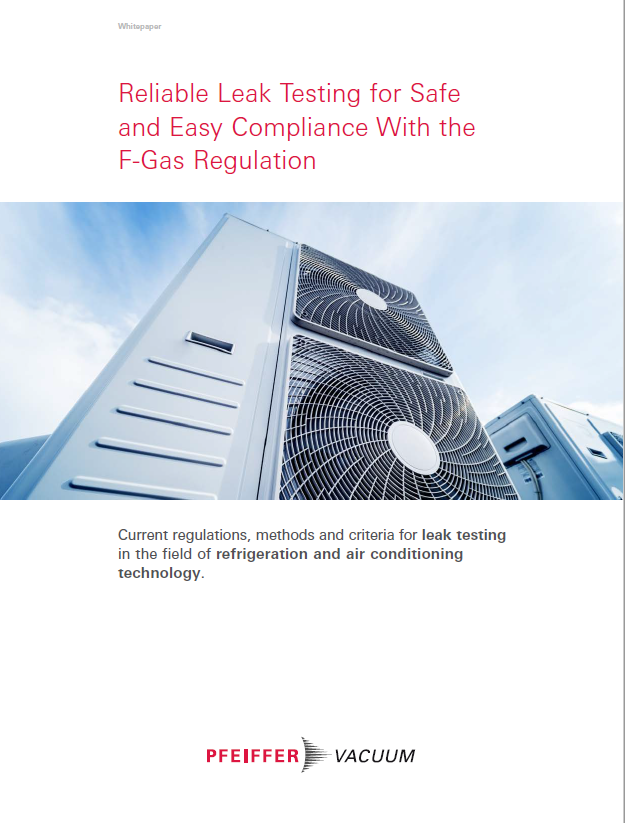Pfeiffer Vacuum’s five tips to improve your leak testing process


Reliable Leak Testing for Safe and Easy Compliance With the F-Gas Regulation
This whitepaper from Pfeiffer Vacuum outlines the current regulations, methods and criteria for leak testing in the field of refrigeration and air conditioning technology.
The aim of the F-Gas regulation is for a gradual reduction of greenhouse gas emissions. In order to achieve this, a wide variety of measures are planned that also affect manufacturers of refrigeration and air conditioning technology.
Thank you.Please check your email to download the Whitepaper.
Manufacturers are under a legal obligation to reduce leaks from heating, ventilation, air conditioning and refrigeration (HAVC-R) equipment they produce.
Under the European Fluorinated Gas (F Gas) Regulations, which are based on the 2016 Kigali Amendment to the Montreal Protocol, manufacturers have to guard against and reduce leakages, and be able to document the steps they have taken to achieve this.
Some of the effects of not carrying out comprehensive leak tests during production to avoid refrigerant leakage can be:
- The direct effect will be to increase adverse climate change, as refrigerants cause ozone depletion and contribute to global warming and is counted as a direct effect on climate change
- Servicing, refrigerant loss, electricity and downtime costs are elevated
- System efficiency is reduced, and it becomes prone to frequent failures
- Power consumption rises, which increases CO2 emissions to produce power, which is an ‘indirect’ effect on climate change.
Tip 1: Vacuum drying
This is critical prior to certifying a piece of equipment ready for use. It is generally accepted that prior to, and during, filling an HVAC-R system with refrigerant, all of its parts need to be free from moisture.
If any water remains on internal surfaces any component – compressor, condenser, evaporator, valves, and tubing. This water could freeze and either block a small pipe or a mechanical component like a valve etc. It can also react with the refrigerants forming acids to cause corrosion or solid deposits to foul systems.
All these issues can be eliminated by well-planned and executed vacuum drying procedures. It helps to extend the useful life of any HVAC-R system to which it has been applied. The moisture is removed using either low-speed, oil-sealed, rotary vane or scroll vacuum pumps providing a stable vacuum to avoid it freezing in the lines. The drying process is carried out under pressures in the mbar range.
Tip 2: Effect of tracer gas dilution
Tracer gases used to pressure test units under test for leakages after vacuum drying can be an expensive proposition unless the system is carefully designed to recover as much of the gas after use as possible.
Leak tests are carried out as a minimum at the operating pressure the unit will face during its working life. When the system is deemed free from moisture or air the tracer gas, either Helium or Hydrogen, is introduced under pressure to test for leaks, so it can reach every part of the HVAC-R refrigerant circulation system and has no interference with other molecules.
The gas concentration, usually much below 100%, will spread throughout the system as it is put under pressure. Using lower concentrations of Helium (which is becoming more and more expensive) and Hydrogen is one of the key methods for saving on costs. A recovery system that can recoup gasses used for leak tests can be an important consideration, but only after a careful review of its ROI to ensure it will be a cost-effective investment.
Pfeiffer Vacuum has a broad range of products to set up leak detection systems in a wide variety of HVAC-R applications. The equipment it supplies can be used to leak-test for Helium, Hydrogen or Forming gas (mix of 95% Nitrogen and 5% Hydrogen), which is used to evacuate and fill the component under test with pressurised gas. Then a sector field mass spectrometer can be used to detect any hydrogen or helium leaking from it. Measuring the amount of tracer gas in a controlled environment over time provides the leak rate.
Tip 3: Test pressure
The appropriate test pressure depends on both the systems to be leak-tested and the tracer gas. The starting point is to know the pressure under which the unit will be operating. Leak tests can be performed in a series, again depending on the conditions set by the above considerations.
According to the European standard DIN EN 378, the minimum leak test pressure should be 0.25 times the operating pressure, rising to 1.43 times the operating pressure, up to as much as 3 times the operating pressure to ensure complete safety of the unit under operational conditions.
Pfeiffer Vacuum engineers usually evaluate the best leak test pressures once they have full knowledge of the equipment and conditions of operation. They have to be careful of difficulties that may arise because if too much pressure is introduced, they may inadvertently alter the internal geometry of the unit and the leak tightness may be different than it was before doing the leak test so the standard rule here is really whenever it’s possible applied operating pressure.
So, the general rule is to begin with understanding the operating conditions of the equipment before planning the leak tests. This also ensures the engineer will use the correct gas mix and the correct gas volume for the most cost-efficient leak-testing setup.
Tip 4: Optimisation of sniffing process
Pfeiffer Vacuum offers a wide range of customer-oriented leak detection training where the operator can be taught the best possible way to achieve this optimisation.
Factors to be taken into consideration are:
- The distance of the sniffer probe from the leak test site can have a great impact on the process and is operator-dependant, but they are trained to be as close as possible.
- The angle at which you place the probe relative to the leak test area is important also, and the recommendation is to be at 90 degrees.
The position relative to the leak test site is key also. The engineers are trained to move the probe from the bottom to the top of the leak test site (the tracer gases usually rise, so you follow its natural path). They systematically ‘bracket’ the leak test site by testing to the right and left also.
Other factors to consider are where the leak test is carried out and the flow rate (suction) of the sniffer probe. These are flexible considerations and are altered to suit the client’s needs.
Tip 5: Consideration of cost of ownership
Where the total cost of ownership is a consideration for maintenance intervals, the robustness of the system, tracer gas consumption and energy consumption, many factors decide which leak test and detection system combinations are suitable for a client.
Pfeiffer Vacuum engineers perform a detailed analysis of each client’s requirements and recommend the most suitable and cost-effective setup. This includes which tracer gas will be used and the gas recovery system, the leak-testing processes, equipment types and number, and the ongoing costs of materials. Owing to the experience of the engineers and the pedigree of Pfeiffer Vacuum’s equipment and after-sales service, the client will benefit from a least-cost, highest-efficiency support solution.
Further details:
Please visit Pfeiffer Vacuum’s Leak Testing Services page for more information

Reliable Leak Testing for Safe and Easy Compliance With the F-Gas Regulation
This whitepaper from Pfeiffer Vacuum outlines the current regulations, methods and criteria for leak testing in the field of refrigeration and air conditioning technology.
The aim of the F-Gas regulation is for a gradual reduction of greenhouse gas emissions. In order to achieve this, a wide variety of measures are planned that also affect manufacturers of refrigeration and air conditioning technology.
Thank you.Please check your email to download the Whitepaper.





